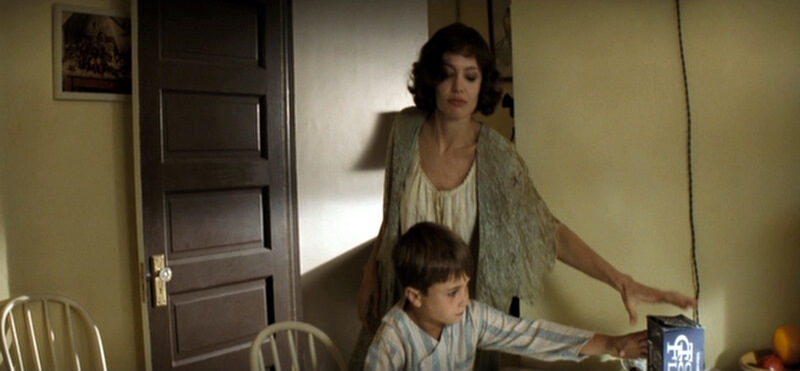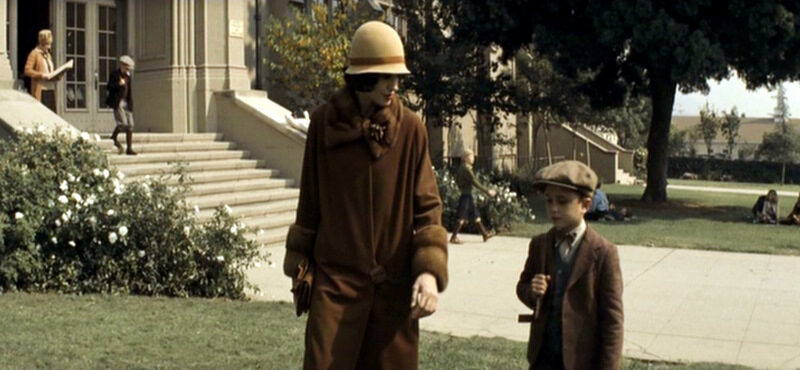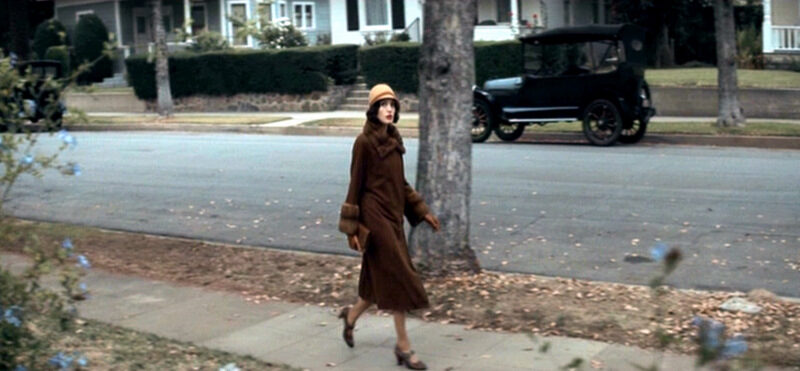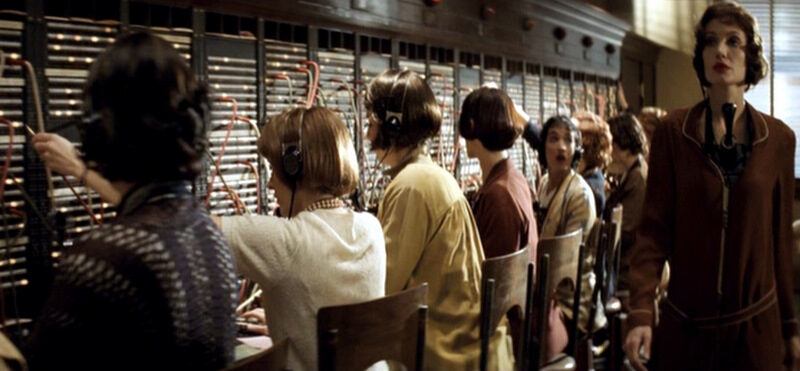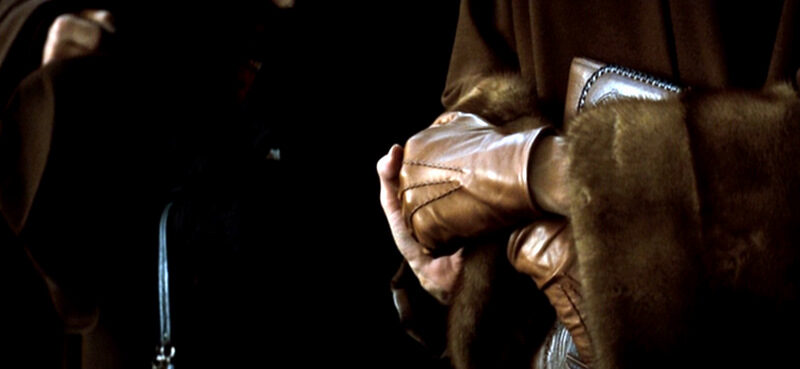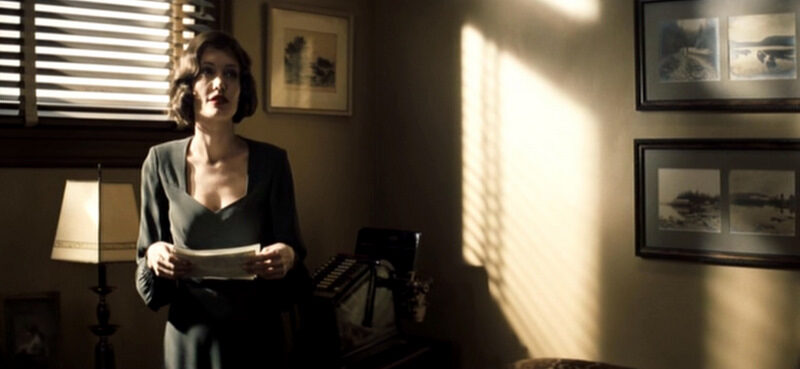Changeling: Angelina Jolie’s Fur Trimmed Coat | Clothes on Film
© 2011, Clothes on Film 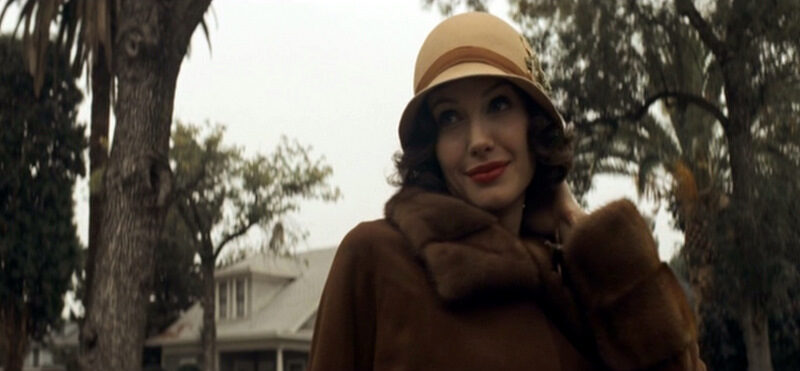
5 May ’10 Filed under Clothes from 1920s, Clothes from 1930s, Girls in Films. Tagged Angelina Jolie, Clint Eastwood, cloche, Clothes from 1920s, Deborah Hopper, flapper, fur coat, lace, mary jane shoes, rayon, shift dress. Bookmark the permalink. Post a comment. Leave a Trackback (URL).
In Changeling (2008, directed by Clint Eastwood), Angelina Jolie plays Christine Collins, a single mother searching for her kidnapped son in late 1920s Los Angeles. A twist in this tale comes when the LAPD return Christine’s son and she immediately knows it is not the same boy. This, however, is only the start of an ordeal that sees fobbed off, lied to, and even committed to a psychiatric hospital. Almost unbelievably the screenplay by J. Michael Straczynski is based on true events.
The film’s costume design by Deborah Hopper affords the kind of spared no expense period recreation that makes movies such as this a real ‘event’. Some doubts were raised at the time of Changeling’s release as to the absolute accuracy of the costumes (could Christine really afford such luxuriant fashions?), yet in a historical, not to mention cinematic context they do work.
Moreover Angelina Jolie suits them all perfectly; in particular the unstructured dresses and cloche hats seem made to accentuate her striking, oh-so photographic features. In just about every possible way Changeling is a costume tour de force.
Indeed Jolie lovingly referred to her outfits as ‘doll clothes’ because they emphasised delicate femininity. While this is true, the 1920s was also a time of considerable change for women; one that saw a rejection of post-World War I dictates to regain bodily curves and long hair. Instead the Great War had granted women an opportunity to work in jobs traditionally reserved for men.
Women did not want to give back this freedom; they wanted to ‘fit in’ with their male colleagues, to be part of a workforce previous denied them. The short bob hair and flattening of curves through side lacer bras was very much part of this.
The costumes in Changeling reflect this point and are faithful to the era without being overly rigid. Influence of Edward Hopper paintings is evident, though Christine is no flapper. Some issues still linger such as an absence of sweaters, Christine’s colourful work attire, especially for a supervisor, and those hemlines encroaching on scandalous even for 1928 before the sartorial and financial crash.
Yet this is an overview of the late 1920s, not historical record. The accessories, unfitted styles and generally ‘flapperish’ air provide immediate recognition for the viewer. Even those with little knowledge of costume history could hazard a guess as to the decade.
The range of outfits create a signature look for Christine, a carefully coordinated mix of luxury and staples. Obviously the lace, scalloped cape dressing gown worn for the opening scene would be former, while the dark brown felt cloche appearing sporadically throughout, the latter. Neatly straddling both ends of the scale is Christine’s fur trimmed coat, certainly the highest profile item in the film and, with possible exception of a dropped waist green rayon dress with matching neck-scarf and gathered sleeves, also the most memorable:
Dark brown wool calf-length unfitted coat; wrapover front with hip level geometric shape one-button fastening, wide fur collar with two matching fur rows to cuffs. Large wooden acorn broach, buff brown felt cloche hat with silk floral accent, mid-brown long pintuck leather gloves and brown leather clutch with tulip stencilling to accessorise.
Dark brown leather Mary Jane shoes with gold buckle.
Worn over dark-brown shift dress; low waist seam, pyjama neckline, single button cuffs, lightly padded shoulders and high inverted pleats to skirt. Trimmed in contrast cream piping.
Christine chooses an especially deep cloche (both in buff and dark brown). It is almost as though she hides herself under it. Point of fact, the brimmed cloche affected posture; it was worn so low over the eyes that women had to stand up straight to be able to see.
Unfitted coats were popular during the latter half of the twenties generally exposing the calf though very rarely the knee. Ornamentation was simple but pronounced and fur would have been used abundantly. Real fur, of course, though Deborah Hopper chose faux both on this and belted version Jolie dons later in the movie.
The acorn broach was originally a necklace cut down. The mind boggles at how large it must have been beforehand. Though this was the style for jewellery back then, costume pearls especially, to be outsized as possible. The piping on Christine’s brown dress is another identifiable touch. Likewise the fancy skirt finish; kilt, circular-cut handkerchief, pegged and uneven hem were oft-seen era styles. Incidentally the adorable Mary Jane shoes were adapted to fit her roller-skates. One gets the impression watching closely that Jolie may not have been the most competent of skaters.
Christine is (and was, remember she did actually exist) a character for whom clothes constituted a form of discipline. Despite their lavishness, the pieces are well chosen to synchronise in colour and fabric. They are ordered and organised, simply yet notably adorned. When her son goes missing, Christine barely loses her poise and immaculate presentation. She retains this as a point of stability; it is only thing left she can control.
The final scenes in Changeling take place in 1935. A shift in fashion occurred in line with economic conditions. Things were serious now. Those flimsy crepe-georgette and crepe-satin dresses were largely confined to evening wear only. Fabrics came heavier and harder wearing, while focus returned to the body, marking out the natural waist, shoulders and décolletage in particular.
We are re-introduced to Christine in this period wearing a green crepe dress with low sweetheart neck line and decorative embroidery. It is similar in shape to a popular Valentina piece from the 1940s, though in the film signifies a shift only to the mid-thirties.
Again whether or not the dress is absolutely accurate is not the point. What this outfit tells us, even if we miss the on-screen subtitles, is that a change has occurred, in terms of time and but also socially. Furthermore Christine is listening to the Academy Award winners as they are announced on the radio, thus providing a hint to the major sartorial influence of the 1930s: movie stars.
Deborah Hopper created a costume aesthetic for Changeling that matched Clint Eastwood’s directional approach; a clean, romantic vision of the past, resolute on storytelling through empathy of character. How many have been motivated to try Christine’s graceful, uncluttered capsule wardrobe after watching this film? If the cloche and shapeless dress require near total commitment to the period, a long fur trimmed coat is more than a step in the right direction.
© 2010 – 2011, Chris Laverty.
Related Posts:
